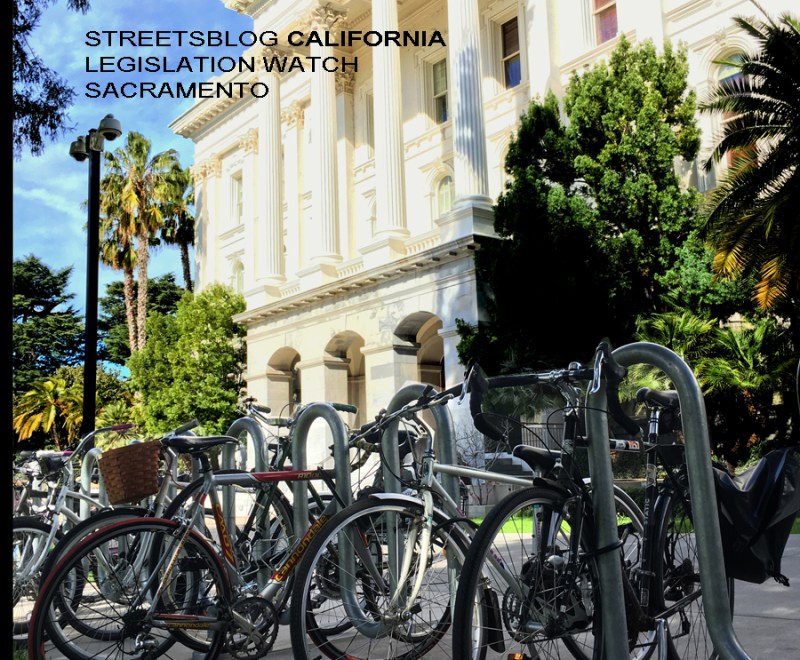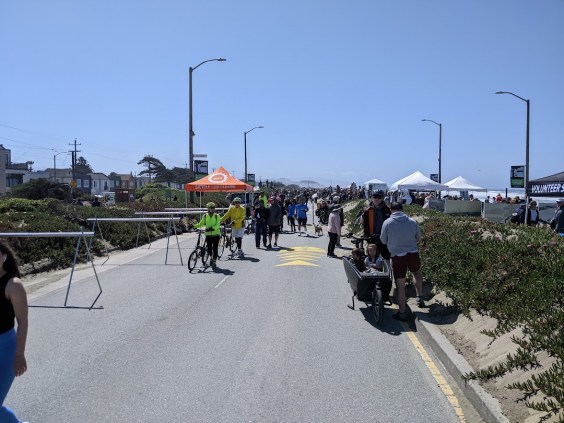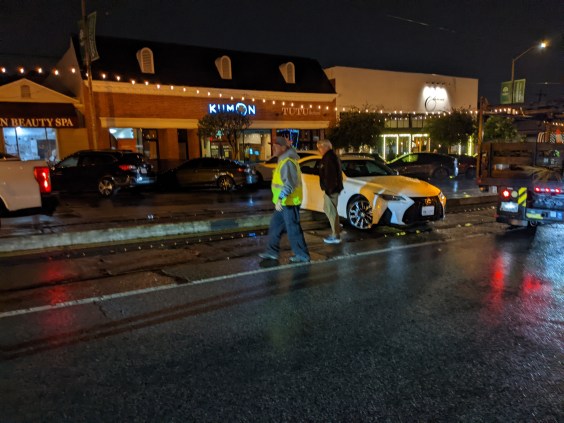In the final days leading up to the legislative recess, with a Friday deadline for bills to pass bills out of committees, the Senate Transportation and Judiciary Committees held long, concurrent meetings on Tuesday to work through a giant pile of bills. Safety and active transportation bills were discussed.
Speed Cameras
The Judiciary committee considered and ultimately passed Assemblymember Laura Friedman's bill to create a pilot program for camera enforcement of speeding (A.B. 645).
Friedman ran off a long list of adaptations and amendments she has made to this years-long effort to get a speed camera pilot program in California. Since the idea was introduced a number of years ago, it has faced opposition around privacy and equity concerns. To allay those concerns, Friedman's bill includes strict rules about storing and using recorded license plate numbers. It also treats speeding tickets like parking tickets, in that they are issued to the car, not the driver. No photos are taken of the drivers (unlike toll booths, which take a photo of both the license plate and the person behind the wheel). Camera enforcement warning signage must be installed at least a month in advance. After that month, programs will only issue warnings for the first sixty days. Drivers have to be going at least 11 miles per hour over the speed limit to be cited, and every driver detected speeding will get a warning the first time. Fines for the citations are low, and can be lowered if necessary.
"A driver would have to receive five tickets before it would cost as much as a speeding ticket issued by an officer," said Friedman. If a camera fails to reduce speeding by at least twenty percent, it would have to be removed. Any moneys raised could only be used to pay for the administration of the program or for traffic calming measures also aimed at reducing speeds, and if there is any extra revenue it would have to be sent to the state Active Transportation Program.
In other words, the author bent over backwards to answer all the objections raised by opponents. Or in the words of Senator Wilk, who said he has "never ever EVER supported a camera enforcement bill" until this one, "this bill is as complex as a manual of pickleball rules."
Nevertheless, the ACLU still spoke up in opposition, saying its focus on enforcement is the problem. "There are other effective means" to achieve the same results, said the ACLU rep. "Rather than center these, [A.B. 645] relies on surveillance, automated enforcement, and increased ticketing. And it transfers the [safety] problem to vulnerable populations." She mentioned several cities in the U.S. that ended their camera enforcement programs because of charges that they were unfair to certain populations.
Friedman insisted that the program would include none of the bias that is a main concern with overpolicing. Even the placement and number of cameras is specified in the bill, to ensure a fair geographic distribution among different communities and avoid focusing on any particular demographic. "Comparing this program with other failed programs that contained none of the privacy and equity provisions in this bill is frankly disingenuous," she countered. Camera enforcement has proven to reduce speeding, she said.
Daylighting Intersections
At the same time, the Senate Transportation Committee was discussing Assemblymember Alex Lee's bill to require "daylighting" intersections, or prohibit parking near corners, to increase sight distances and safety (A.B. 413). The conversation focused partly on local control, and whether making this a statewide rule was appropriate. The National Highway Traffic Safety Administration "has proven it is effective in reducing fatalities," according to Marc Vukcevich of Streets for All, a sponsor of the bill. "And NACTO - which is made up of city traffic engineers - recommends daylighting at intersections."
Assemblymember Lee accepted amendments that give local jurisdictions control over signage and markings, and allows some local discretion on how far to maintain the no-parking zone and whether to allow delivery drivers to use the space.
"At end of the day, this is about improving safety," said Lee. The bill passed.
Sidewalk Riding
A.B. 825, from Assemblymember Isaac Bryan, also passed the committee. This bill would make it legal to ride a bike on a sidewalk on any street that lacked good biking infrastructure. The author added a sunset provision to the bill, and a requirement that the CHP report on its impact to the legislature in 2029. The impetus for this bill are statistics that show a stark contrast in who gets ticketed currently for riding a bike on the sidewalk - a practice that is legal in some places but not everywhere, and different from city to city.
"Despite no evidence that sidewalk riding is not different among races, most citations go to Latinos, with over ninety percent of them issued to people of color," said Bryan. "We criminalize only certain folks; we shouldn't do that."
Bike riders themselves "should have the autonomy to decide whether sidewalks are safer than street," he said. Bryan cited statistics on how collisions between bikes and cars decrease when sidewalk riding is legalized.
Transportation Planning
Another key and controversial bill that passed would require transportation and highway planners to incorporate the principles of California's Climate Action Plan for Transportation Investment (CAPTI) in their work. A.B. 7, also from Assemblymember Friedman, is another attempt to bring California's transportation planning in line with climate goals.
Senator Josh Newman asked Assemblymember Friedman how this bill differed from a previous version she had tried, and failed, to get passed last year. This one, she said, is less prescriptive; it encourages the incorporation of climate-positive principles but doesn't give a strict timeline. She added that a key part of this bill is that it brings transparency to the planning process so that the public has a better idea of what is being planned and how climate is taken into account in those plans.
The bill was opposed by several groups, on somewhat unclear grounds; the California Building Association objected that the bill would give teeth to what is now only a "document" resulting from a Governor's Executive Order. By putting it in statute, it would give opponents a tool to use against projects.
When a representative from OCTA explained their opposition to the bill's ambiguity and lack of detail - "and uncertainty with what that looks like in the out years" - Friedman politely refrained from rolling her eyes.
"It is ironic," she said, "that we're trying to make it less prescriptive, so now ambiguity is being brought up as a problem." The fact that the Governor's Executive Order didn't go through any legislative policy committee "is the reason we are here," she said. "Without us taking this action, then we have an Executive Order without a policy discussion, and without the transparency that is [required] in this bill."
Once again, as in previous discussions, questions were asked about whether projects being built with gas tax money would be delayed. "Let me be very clear: there is nothing in this legislation that can derail a project" that is already planned, said Friedman.
Senator Kelly Seyarto, who represents the Inland Empire, was unhappy. "Our roads aren't there yet," he complained. "If we don't get these roads built to the same level that you have in Orange County, in L.A. County, even in San Diego, it's going to be hard to justify accommodating the housing they want out there!"
"Think of all the people out there who have to commute to go to job centers at least 45 miles, sometimes 100 miles away!" he added. "The traffic we have out in those areas is contributing more to air pollution and greenhouse gases while these cars are sitting in traffic for hours… The expectation when S.B.1 passed was that our roads would be pristine."
Friedman responded: "Look at the mistakes we've made [in L.A. and Orange Counties]. Adding more and more highways has not solved congestion, and it has hampered other [more climate-friendly] infrastructure." Now California has to "turn the clock back on that."
"In your area, there are wonderful and transformative projects that they want to build," she added, " but leadership has to agree on goals."
"There are things we can do that are complementary" to wider and faster highways. "I am just asking for us to take a pause and think about what else we can do," she (gently) urged.
Youth Transit Passes
Assemblymember Chris Holden's umpteenth bill to create a free youth transit pass (A.B. 610) was passed without discussion, as part of the consent calendar.
Bicycles at Stop Signs
Assemblymember Tasha Boerner removed her bill (A.B. 73) that would allow bike riders to treat stop signs as yields from the committee agenda. No reason was offered.
This happened to a previous bill of hers, last year's A.B. 1713, which she pulled before its final vote because she believed Governor Newsom would veto it.






